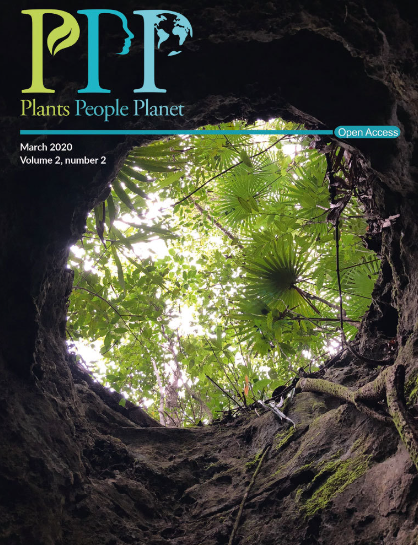Global access to nomenclatural botanical resources: Evaluating open access availability
IF 3.6
2区 环境科学与生态学
Q1 BIODIVERSITY CONSERVATION
引用次数: 3
Abstract
Societal Impact Statement Primary occurrence data ( ‘ what, where, when ’ ) enable study of species distribution and diversity, facilitating reactions to societal challenges from food security to climate change mitigation. Scientific names integrate information and are made concrete through reference to a type specimen. Research and conservation planning requires timely open access to this data. Around 2000 vascular plant species are described each year, and many are narrowly endemic and face conservation threats. Twenty‐four percent of those published between 2012 and 2021 is available openly, and only 12% of taxa is represented by digitised type material served from within their native range. We make several recommendations to increase open access to this vital information to support prompt conservation action and future research. Summary We review access to literature and type specimens, key resources for taxonomic research. Takeup of open access (OA) publishing in plant naming is analysed using the International Plant Names Index (IPNI) data (2012–2021), and online availability of specimens analysed using the Global Biodiversity Information Facility (GBIF). Integration of the World Checklist of Vascular Plants (WCVP) taxonomy and distributional data is used to examine regional variation. We found that 23% of vascular plant names are published OA, and 41% are digitally undiscoverable: contained in bibliographic works without a Digital Object Identifier (DOI) or with an unresolvable DOI. The most common OA publishing model used is ‘gold’. We also found that 30% of taxa are represented by a digitised type specimen mobilised from within the continent of their natural range and only 12% from the (more precise) country. We recommend clear article processing charge (APC) waivers for authors from low and middle income countries to better enable ‘gold’ OA and promotion of deposition repositories to better enable ‘green’ OA. Nomenclators should clearly indicate the OA status of literature and mobilise type citation data as material citations to aggregators like GBIF. Names registration systems should promote the capture of code‐recommended elements such as catalogue numbers for type specimens. Digital mobilisation of specimen metadata and images from collections based in low‐ and middle‐income countries must be accelerated to help increase in country taxonomic capacity to document and conserve plant diversity.命名植物资源的全球获取:评估开放获取的可用性
主要发生数据(“什么、在哪里、何时”)有助于研究物种分布和多样性,促进应对从粮食安全到减缓气候变化等社会挑战。科学名称整合了信息,并通过参考模式标本而具体化。研究和保护规划需要及时开放这些数据。每年约有2000种维管植物被描述,其中许多是狭窄的地方性物种,面临保护威胁。在2012年至2021年间出版的分类群中,有24%是公开的,只有12%的分类群是由其原生范围内的数字化类型材料代表的。我们提出了一些建议,以增加对这些重要信息的开放获取,以支持及时的保护行动和未来的研究。本文综述了分类研究的主要资源——文献和模式标本。利用国际植物名称索引(IPNI)数据(2012-2021)分析了开放获取(OA)出版在植物命名方面的使用情况,并利用全球生物多样性信息设施(GBIF)分析了标本的在线可用性。结合世界维管植物名录(World Checklist of Vascular Plants, WCVP)的分类和分布数据,研究了维管植物的区域差异。我们发现23%的维管束植物名称是OA出版的,41%是数字无法发现的:包含在没有数字对象标识符(DOI)或无法解析的DOI的书目作品中。最常见的OA发行模式是“黄金”模式。我们还发现,30%的分类群是由从其自然分布范围内的大陆调动来的数字化模式标本代表的,只有12%来自(更精确的)国家。我们建议为来自中低收入国家的作者提供明确的文章处理费(APC)豁免,以更好地实现“黄金”开放获取,并促进沉积库以更好地实现“绿色”开放获取。命名者应明确指出文献的开放获取状态,并将类型引文数据作为材料引文动员到GBIF等聚合器中。名称注册系统应促进获取代码推荐的元素,如类型标本的目录编号。必须加快对低收入和中等收入国家采集的标本元数据和图像进行数字化动员,以帮助提高国家记录和保护植物多样性的分类能力。
本文章由计算机程序翻译,如有差异,请以英文原文为准。
求助全文
约1分钟内获得全文
求助全文
来源期刊

Plants People Planet
Multiple-
CiteScore
9.90
自引率
5.90%
发文量
81
审稿时长
12 weeks
期刊介绍:
Plants, People, Planet aims to publish outstanding research across the plant sciences, placing it firmly within the context of its wider relevance to people, society and the planet. We encourage scientists to consider carefully the potential impact of their research on people’s daily lives, on society, and on the world in which we live. We welcome submissions from all areas of plant sciences, from ecosystem studies to molecular genetics, and particularly encourage interdisciplinary studies, for instance within the social and medical sciences and chemistry and engineering.
 求助内容:
求助内容: 应助结果提醒方式:
应助结果提醒方式:


